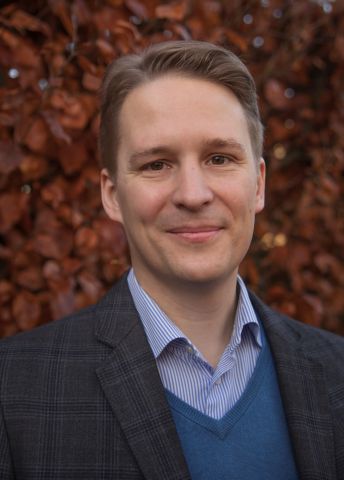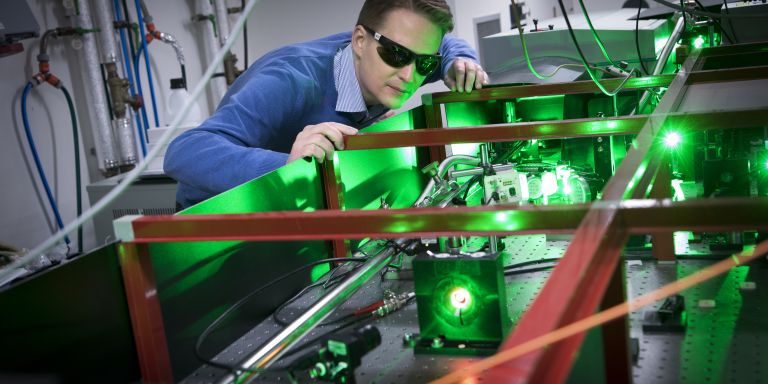
Olle Lundh
Associate Professor of Physics
Wallenberg Academy Fellow, prolongation grant 2019
Institution:
Lund University
Research field:
Particle acceleration using high-power laser


Wallenberg Academy Fellow, prolongation grant 2019
Institution:
Lund University
Research field:
Particle acceleration using high-power laser
The uses of ultra-high-energy particles include material studies, cancer radiotherapy, and examination of chemical and physical processes at molecular level. Accelerators several kilometers long are normally needed to give particles the required energy, but the high-power laser at Lund University has enabled Lundh to create a device that achieves the same effect over a distance of less than half a meter.
The laser irradiates gases, which become so energetic that their atoms split up into ions and free electrons – a plasma made up of charged particles. As the laser pulse moves through the gas, the electrons are pushed backward in strong surge. This movement produces ultra-strong electric fields, so strong that the acceleration distance can be reduced to one-thousandth of that needed in accelerator facilities such as CERN and MAX IV.
Lundh is now working with MAX IV to find a way of connecting the plasma technology up to one of their beamlines, and in just half a meter double the energy in the particles exiting the 300-meter-long accelerator.
“Hopefully we’ll put together an experimental station that demonstrates the potential our technology offers for becoming part of future facilities. There are similar projects affiliated with CERN and other facilities. The experiment would raise Sweden’s profile in this field,” says Lundh.
He believes we will see facilities based entirely on the plasma technology, but that it may take a few decades. For his own part, he is more interested in the near term potential.
He is using the new methods in a project to develop new cancer therapies. Tumors are usually irradiated with X-rays, but in recent years proton radiotherapy has shown itself to be a promising alternative. Protons give a more precise and better targeted radiation dose, but the equipment is bulky. Sweden only has one such unit, which limits the number of patients who can be treated in this way. Lundh and his colleagues want to ascertain whether their high-energy electrons can have a similar effect to protons.
“We’re testing ways of targeting a highly specific area by aiming the electrons from different angles. It definitely offers potential. With the help of a plasma accelerator, the unit could be adapted to suit normal hospital environments instead of requiring a large laboratory, as with proton radiotherapy.”
The acceleration in the plasma also generates X-rays, which are used in other projects. Lundh is collaborating with experts in combustion physics on a study into what happens when larger droplets in aerosols rapidly split up into smaller one. Understanding this process is vital in order to optimize combustion processes where the fuel is jetted. He is participating in another study with international experts in astrophysics to see how materials behave under extremely high pressure and temperature, as in the core of our planet.
“Being a Wallenberg Academy Fellow gives me the freedom to develop my ideas. I can delve deep into research issues that take a long time to resolve.”
And development of the accelerator technology continues. Among other things, Lundh wants to create a sort of waveguide, a channel to focus the laser beam. This is because it starts to disperse, as light does, after a short distance, declining in intensity.
“Using a fiber-optic cable to channel the light wouldn’t work – the laser would destroy it. We need to find a method that works at such high intensity. We’re now trying to create a channel in the plasma using ultrasound.”
A cylindrical loudspeaker encasing the plasma may enable the scientists to create variations in density, shaping a channel right in the center, where the laser beam is.
Even in his early teens Lundh wanted to be a researcher. He borrowed textbooks intended for much older students, and later for university courses, even though he did not understand much of what was written. First he wanted to be an astrophysicist, then a geneticist, then a computer programmer. But he is very pleased with his ultimate choice of research field.
“As a researcher in plasma acceleration, you have the potential to make a mark beyond the realms of basic research. Other researchers can benefit from this technology, but it’s also possible to build machinery and methods that ensure my findings are of benefit to society at large. That’s a key driver for me.”
His career is now so far advanced that much of the practical work involved in his research is done by PhD students under his supervision. It took him a while to get used to this, but he now likes it, and has realized he can drive his research forward by creating a good research environment for his colleagues and teaching them about the pitfalls and opportunities of the work.
“There has to be a balance between instructing them and giving them freedom – freedom both to do things I hadn’t even thought of, and freedom to fail. Then they can take on a creative research role.”
Text Lisa Kirsebom
Translation Maxwell Arding
Photo Åsa Wallin